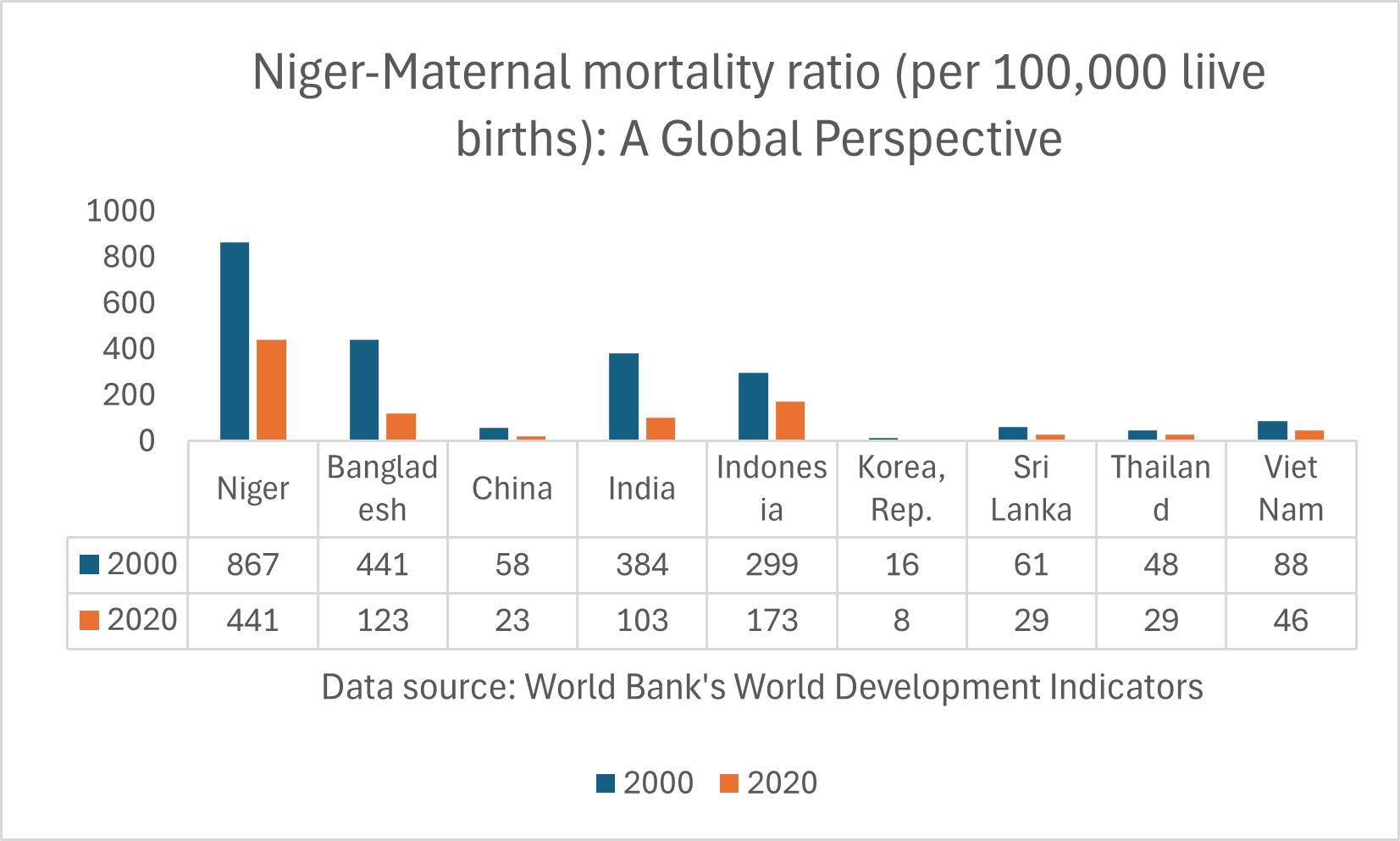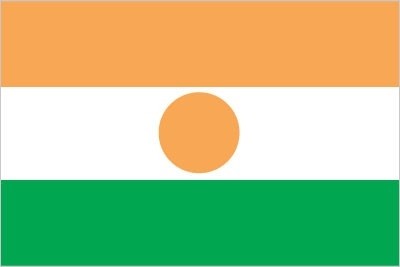
Niger
Country Flag Details
three equal horizontal bands of orange (top), white, and green with a small orange disk centered in the white band; the orange band denotes the drier northern regions of the Sahara; white stands for purity and innocence; green symbolizes hope and the fertile and productive southern and western areas, as well as the Niger River; the orange disc represents the sun and the sacrifices made by the people
note: similar to the flag of India, which has a blue spoked wheel centered in the white band
Background
Niger became independent from France in 1960 and has struggled to maintain a democratic system of government. It is one of the poorest countries in the world with insufficient funds to develop its resource base. The largely agrarian and subsistence-based economy is frequently disrupted by extended droughts common to the Sahel region of Africa.
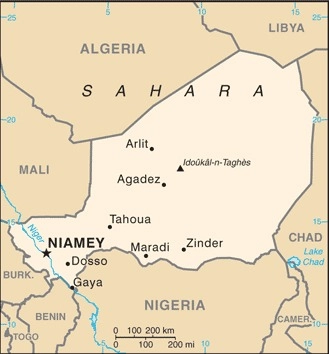
Geography
Area
total: 1.267 million sq km
land: 1,266,700 sq km
water: 300 sq km
Climate
desert; mostly hot, dry, dusty; tropical in extreme south
Natural resources
uranium, coal, iron ore, tin, phosphates, gold, molybdenum, gypsum, salt, petroleum
People and Society
Population
total: 26,342,784
Ethnic groups
Hausa 53.1%, Zarma/Songhai 21.2%, Tuareg 11%, Fulani (Peuhl) 6.5%, Kanuri 5.9%, Gurma 0.8%, Arab 0.4%, Tubu 0.4%, other/unavailable 0.9% (2006 est.)
Languages
Hausa, Zarma, French (official), Fufulde, Tamashek, Kanuri, Gurmancema, Tagdal
Religions
Muslim 95.5%, ethnic religionist 4.1%, Christian 0.3%, agnostics and other 0.1% (2020 est.)
Population growth rate
3.66% (2024 est.)
Government
Government type
formerly, semi-presidential republic
Capital name: Niamey
Executive branch
chief of state: President of the National Council for the Safeguard of the Homeland (CNSP) General Abdourahame TIANI (since 28 July 2023)
head of government: CNSP Prime Minister Ali Mahaman Lamine ZEINE (since 9 August 2023)
Economy
Real GDP (purchasing power parity)
$44.561 billion (2023 est.)
$43.474 billion (2022 est.)
$38.851 billion (2021 est.)
Real GDP per capita
$1,700 (2023 est.)
$1,700 (2022 est.)
$1,600 (2021 est.)
Exports
$1.376 billion (2022 est.)
$1.487 billion (2021 est.)
$1.338 billion (2020 est.)
Exports – partners
UAE 31%, France 23%, China 18%, India 6%, Sweden 5% (2023)
Exports – commodities
gold, oil seeds, uranium and thorium ore, radioactive chemicals, refined petroleum (2023)
Imports
$4.194 billion (2022 est.)
$4.027 billion (2021 est.)
$3.542 billion (2020 est.)
Imports – partners
China 26%, France 15%, India 12%, Nigeria 7%, UAE 6% (2023)
Imports – commodities
rice, aircraft parts, iron structures, refined petroleum, centrifuges (2023)

Export structure by product group in 2023 (% of total export)(UNCTAD)
The export structure of a nation serves as a crucial reflection of the variety, composition, and value of its goods and services in the global marketplace, offering essential insights into the country’s economic health, competitive positioning, and level of development. In the case of Niger, this export structure is predominantly centered around mining and petroleum goods, while also incorporating significant contributions from the agricultural sector. To effectively address economic vulnerabilities and cultivate sustainable growth over the long term, it is vital to implement comprehensive strategies that focus on diversification and promote sustainable development across various sectors of the economy.
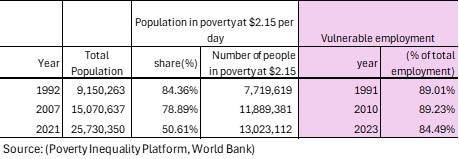
Poverty and vulnerable employment in Niger (World Bank)
Understanding poverty level significance at $2.15
In 2021, 51 percent of the population in Niger lived in poverty at $2.15 per day. The poverty level at $2.15 per day (measured in 2017 purchasing power parity, or PPP) is a key global benchmark used by the World Bank to define extreme poverty in low-income countries. It indicates:
1. Basic Survival Threshold
• People living below $2.15 per day struggle to afford essential needs such as food, clean water, shelter, healthcare, and education.
2. Economic Underdevelopment
• A high percentage of a country’s population living below this threshold suggests low economic productivity, high unemployment, and weak social safety nets.
3. Inequality and Social Vulnerability
• It reflects deep income inequality and a lack of access to opportunities for upward mobility.
• People in this category are more vulnerable to shocks like food price increases, climate disasters, or health crises.
4. Policy Challenges
• Governments need targeted interventions such as social welfare programs, job creation, and improved access to education and healthcare to reduce poverty.
A country's export structure is a reflection of its level of development and productive capacities
The export structure of a country refers to the composition, diversity, and value of the goods and services it sells to other countries. It provides key insights into the country’s economic health, competitiveness, and level of development. Productive capacities of a country refer to its ability to produce goods and services efficiently and sustainably over time. These capacities are shaped by various factors, including human capital, natural resources, infrastructure, private sector, development, technology & innovation, institutions & governance, financial systems trade & market access.
Here’s what the export structure and productive capacities of a country typically indicate:
- Level of Economic Development
- Developed economies usually export high-value manufactured goods, technology, and services.
- Developing economies often rely on raw materials, agricultural products, or low-value manufactured goods.
- Industrial and Sectoral Strengths
- A strong presence of high-tech or industrial goods (e.g., machinery, electronics) suggests a well-developed manufacturing sector.
- A dominance of commodities (e.g., oil, minerals, agricultural products) indicates reliance on natural resources.
- Export Diversification
- A diverse export base (multiple industries) makes a country’s economy more stable and resilient to global price shocks.
- A concentrated export base (few key products) makes it vulnerable to market fluctuations.
- Trade Partnerships and Dependence
- If exports are heavily dependent on a single country or region, the economy is more exposed to geopolitical and trade risks.
- A wide range of trading partners indicates stronger global integration.
- Competitiveness and Value Addition
- Exporting mainly raw materials (e.g., crude oil instead of refined petroleum) suggests limited industrial processing capacity.
- A high share of finished and high-tech goods suggests strong value addition and competitiveness.
Niger-Sanitation
Niger – Proportion of total population served with at least basic sanitation
In 2022, proportion of population served with at least basic sanitation for Niger was 16.4 %. Proportion of population served with at least basic sanitation of Niger increased from 5.5% in 2000 to 16.4 % in 2022 an absolute change of 10.9 percentage points (pp) between 2000 and 2022.
Niger – Proportion of urban population served with at least basic sanitation
In 2022, proportion of urban population served with at least basic sanitation for Niger was 52.8 %. Proportion of urban population served with at least basic sanitation of Niger increased from 24.2 % in 2000 to 52.8 % in 2022 an absolute change of 28.6pp between 2000 and 2022.
Niger – Proportion of rural population served with at least basic sanitation
In 2022, proportion of rural population served with at least basic sanitation for Niger was 9 %. Proportion of rural population served with at least basic sanitation of Niger increased from 1.9 % in 2000 to 9 % in 2022 an absolute change of 7.1 pp between 2000 and 2022.
Niger – Proportion of total population served with at least basic sanitation
The lack of safe sanitation is a critical issue demanding urgent action, leading to preventable deaths of hundreds of thousands annually and highlighting a major public health crisis. Safe sanitation is a fundamental human right essential for all. In 2022, around 23 million people, or 84 percent of Mauritania’s population, faced severe consequences from inadequate sanitation, a stark contrast to countries like Vietnam, China, and Thailand, where only 8 percent, 5 percent, and 1 percent lacked these vital services. The global average is about 6 percent, stressing the need for united efforts to improve sanitation access in the most underserved areas of Sub-Saharan Africa, where the effects of poor sanitation are most profound.

Niger – Proportion of rural population served with at least basic sanitation
In 2022, nearly 18 million people in rural Niger, or about 81% of the population, lacked basic sanitation facilities, starkly contrasting with access rates of 12%, 5%, and 2% in Vietnam, Sri Lanka, and Thailand respectively. This absence of safe sanitation is not just an urgent issue; it is a grave humanitarian crisis that demands our immediate action, as it leads to countless preventable deaths each year. Safe sanitation is a fundamental human right that everyone deserves, regardless of their location or socio-economic status. It is crucial for us to unite in advocating for this essential right across Sub-Saharan Africa, where the need for improved sanitation is urgent and the potential for transformative change is vital for health and dignity.

Niger-Water Supply
Niger- Proportion of total population served with at least basic drinking water
In 2022, proportion of population served with at least basic water for Niger was 48.9 %. Proportion of population served with at least basic water of Niger increased from 37.5 % in 2000 to 48.9 % in 2022 an absolute change of 11.4 pp between 2000 and 2024.
Niger – Proportion of urban population served with at least basic drinking water
In 2022, proportion of urban population served with at least the basic drinking water for Niger was 88.3 %. Proportion of urban population served with at least the basic drinking water of Niger fell gradually from 91.2 % in 2000 to 88.3 % in 2022, an absolute change of 2.9 pp between 2000 and 2022.
Niger – Proportion of rural population with at least basic drinking water
In 2022, proportion of rural population served with at least basic water for Niger was 40.9 %. Proportion of rural population served with at least basic water of Niger increased from 27.1% in 2000 to 40.9 % in 2022 an absolute change of 13.8 pp between 2000 and 2022.
Niger- Proportion of total population served with at least basic drinking water: A Global Perspective.
Access to safe drinking water is a fundamental human right critical for health and well-being. In 2022, about 14 million people in Niger, nearly 51 percent of the population, lacked this essential resource, revealing a troubling inequality in access to basic needs. In contrast, everyone in Thailand had access to safe drinking water, with 98 percent of populations in Bangladesh and Vietnam also having this right. These disparities highlight the urgent need for compassionate efforts to improve living conditions and ensure equitable access to safe drinking water for vulnerable communities in Sub-Saharan Africa, where the effects of such inequalities demand our immediate attention and action.
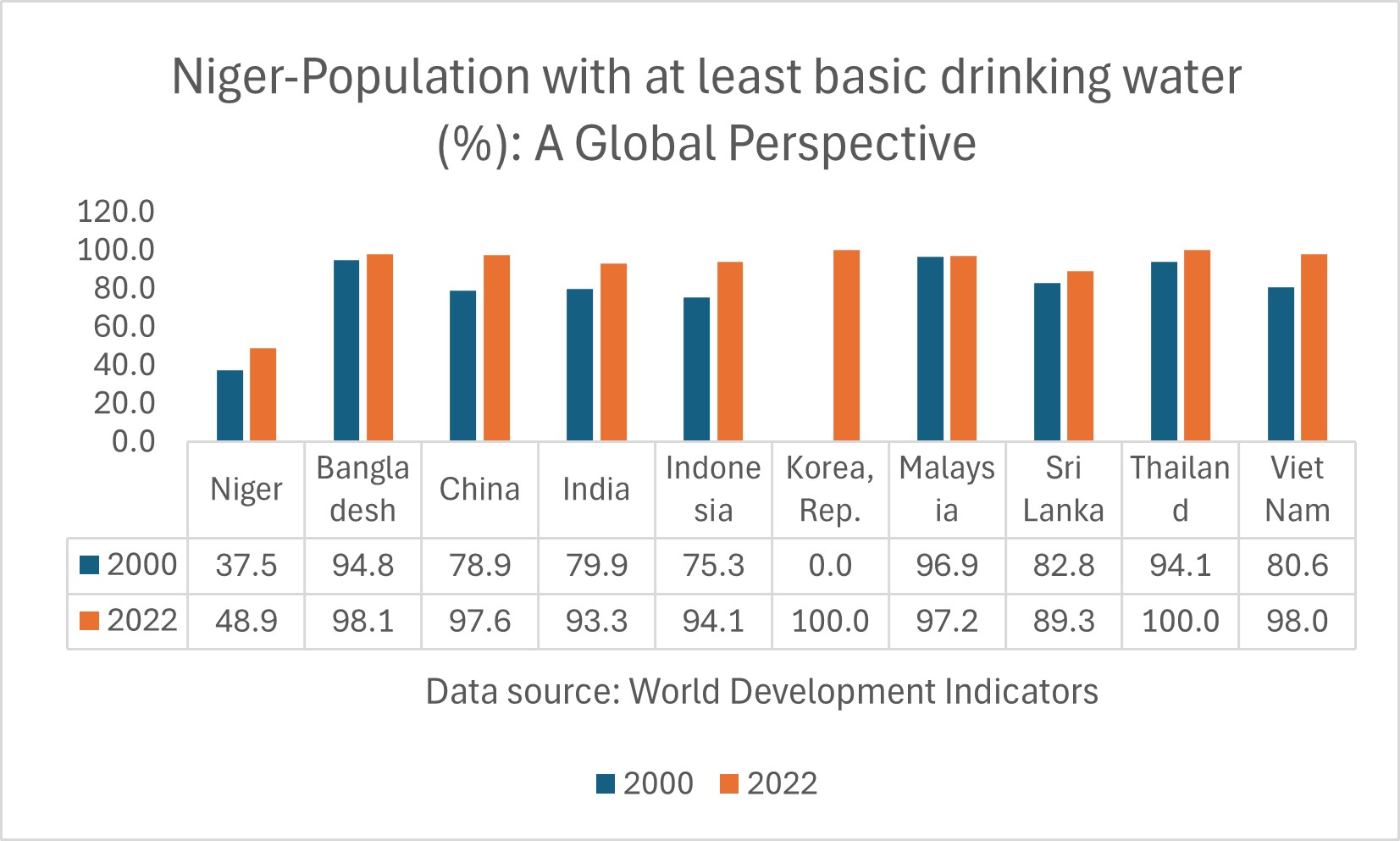
Niger- Proportion of rural population served with at least basic drinking water: A Global Perspective
In 2022, a concerning 59 percent of Niger’s rural population lacked access to drinking water facilities, leaving about 11 million people without safe drinking water sources essential for health. This situation starkly contrasts with countries like Thailand and Bangladesh, where 100 percent and 98 percent of rural populations had access to safe drinking water, respectively. This disparity highlights the urgent need for transformative action across Sub-Saharan Africa, emphasizing the importance of addressing root causes of water accessibility and sustainability to ensure equitable access for all, improve health outcomes, and enhance quality of life for affected communities.
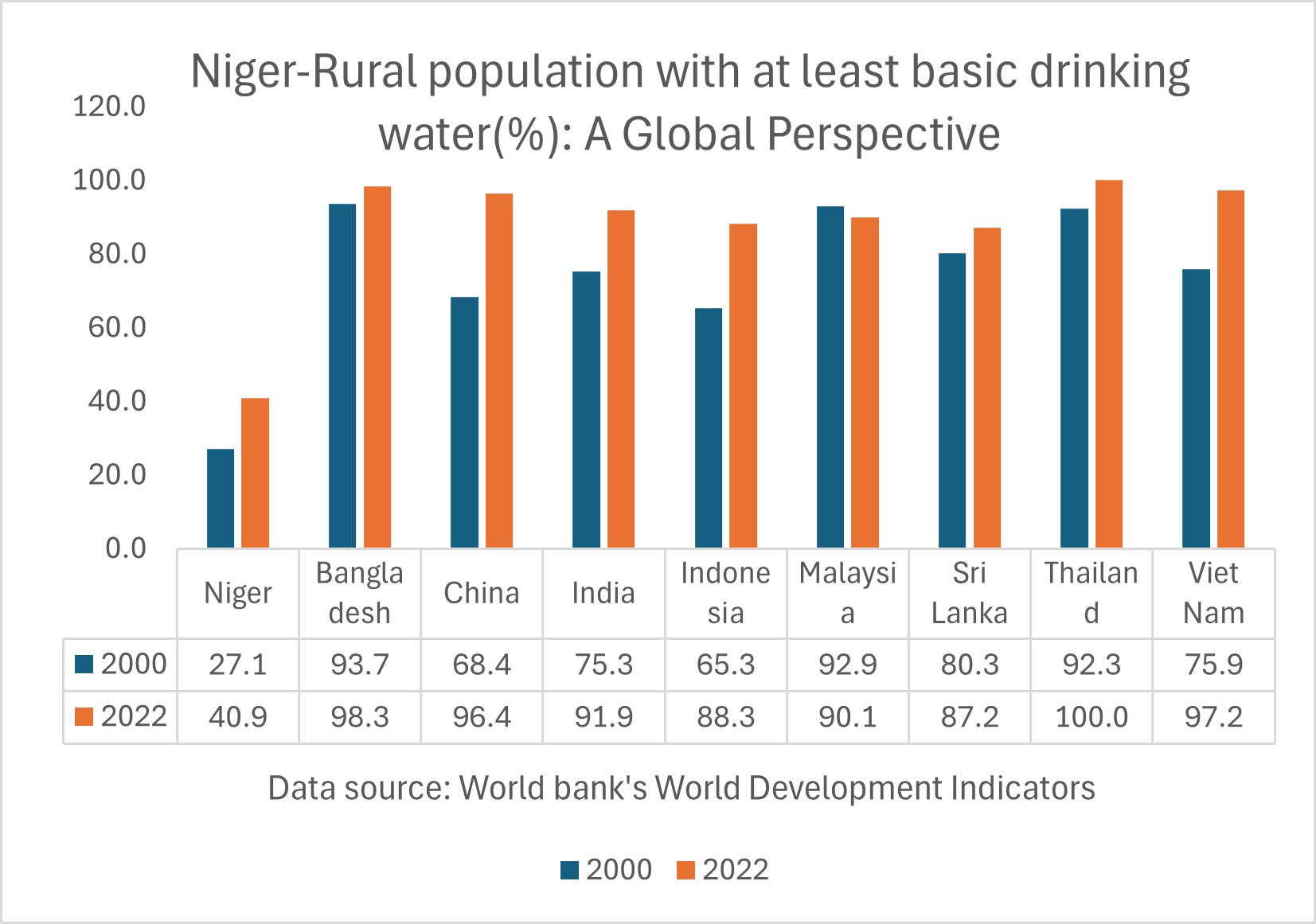
Niger-Access to Electricity
Niger-Access to electricity (% of population)
In 2022, proportion of population with access to electricity for Niger was 19.5%. The proportion of population with access to electricity of Niger increased from 6.5% in 2000 to 19.5% in 2022, an absolute change of 13 pp between 2000 and 2022.
Niger-Access to electricity (% urban population)
In 2022, proportion of urban population with access to electricity for Niger was 66.1%. The proportion of urban population with access to electricity of Niger increased from 40.7% % in 2000 to 66.1% in 2022, an absolute change of 25.4 pp between 2000 and 2022.
Niger-Access to Electricity (% rural population)
In 2022, proportion of rural population with access to electricity for Niger was 7.7 %. The proportion of rural population with access to electricity of Niger increased from 4.8% in 2010 to 7.7% in 2022, an absolute change of 2.9 pp between 2000 and 2022.
Niger- Proportion of total population served with electricity: A Global Perspective
In 2022, nearly 80 percent of Niger’s population lacked access to electricity, affecting over 21 million people who are deprived of this essential service for their daily lives and economic participation. This stark disparity contrasts sharply with countries like Vietnam, Thailand, Sri Lanka, and Malaysia, where electricity access has reached 100 percent, highlighting the urgent reforms needed across Sub-Saharan Africa to improve citizens’ quality of life. Reliable electricity is not just a convenience; it is a vital foundation for development, health, and education, fostering economic growth and raising living standards while paving the way for a more equitable future.
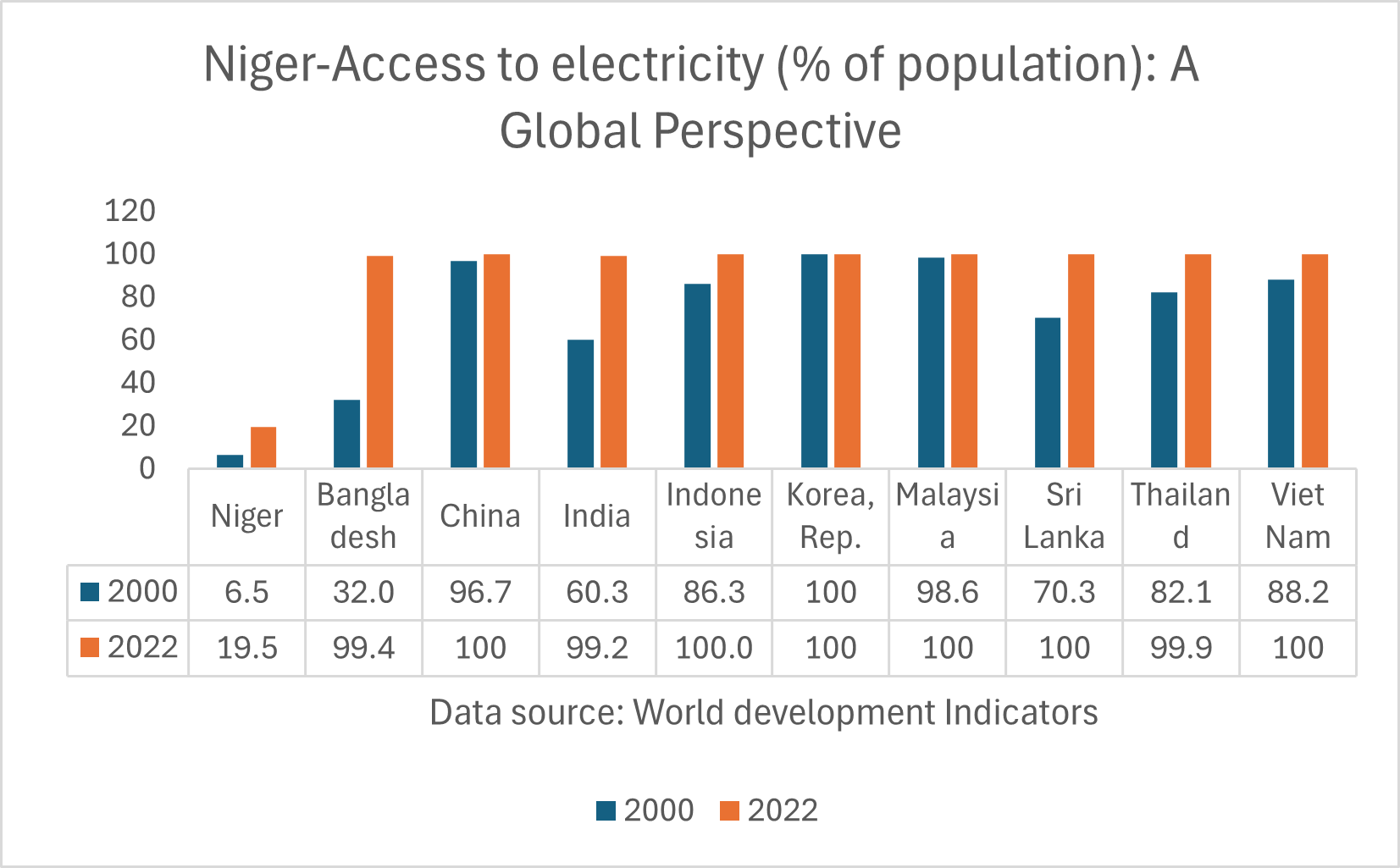
Niger- Rural population with access to electricity: A Global Perspective.
In 2022, an alarming 92% of Niger’s rural population, nearly 21 million people, lived without electricity, starkly contrasting with nations like Vietnam, Thailand, and Sri Lanka, where everyone in rural areas has access to this essential resource. India and Bangladesh have made significant progress, with 99% of their rural citizens enjoying electricity in their daily lives. These figures highlight the urgent need for genuine and transformative governance reforms across Sub-Saharan Africa, ensuring every community has reliable access to electricity, a fundamental right that empowers individuals and fosters a more sustainable future.

Niger- Health outcomes
Niger-Life expectancy: A Global Perspective
As we examine life expectancy trends over the past seven decades, it becomes clear that, despite significant advancements leading to longer and healthier lives for many, stark inequalities remain, particularly in Sub-Saharan Africa. The global average life expectancy for newborns has risen from 47 years in 1950 to 71 years by 2021; however, progress in many Sub-Saharan African nations is alarmingly slow. For instance, Niger’s life expectancy has increased from 36 years in 1960 to only 62 years in 2022, highlighting persistent challenges for its citizens. In contrast, countries like South Korea have seen life expectancy rise from 54 years in 1960 to an impressive 83 years in 2022, while the Maldives has improved from 39 years in 1960 to 81 years in 2022. The ongoing low life expectancy in various Sub-Saharan African nations serves as a reminder of the urgent issues they face, including chronic poverty and underfunded healthcare systems, necessitating transformative actions to create a sustainable and equitable future that ensures a better life for marginalized communities across Sub-Saharan Africa.
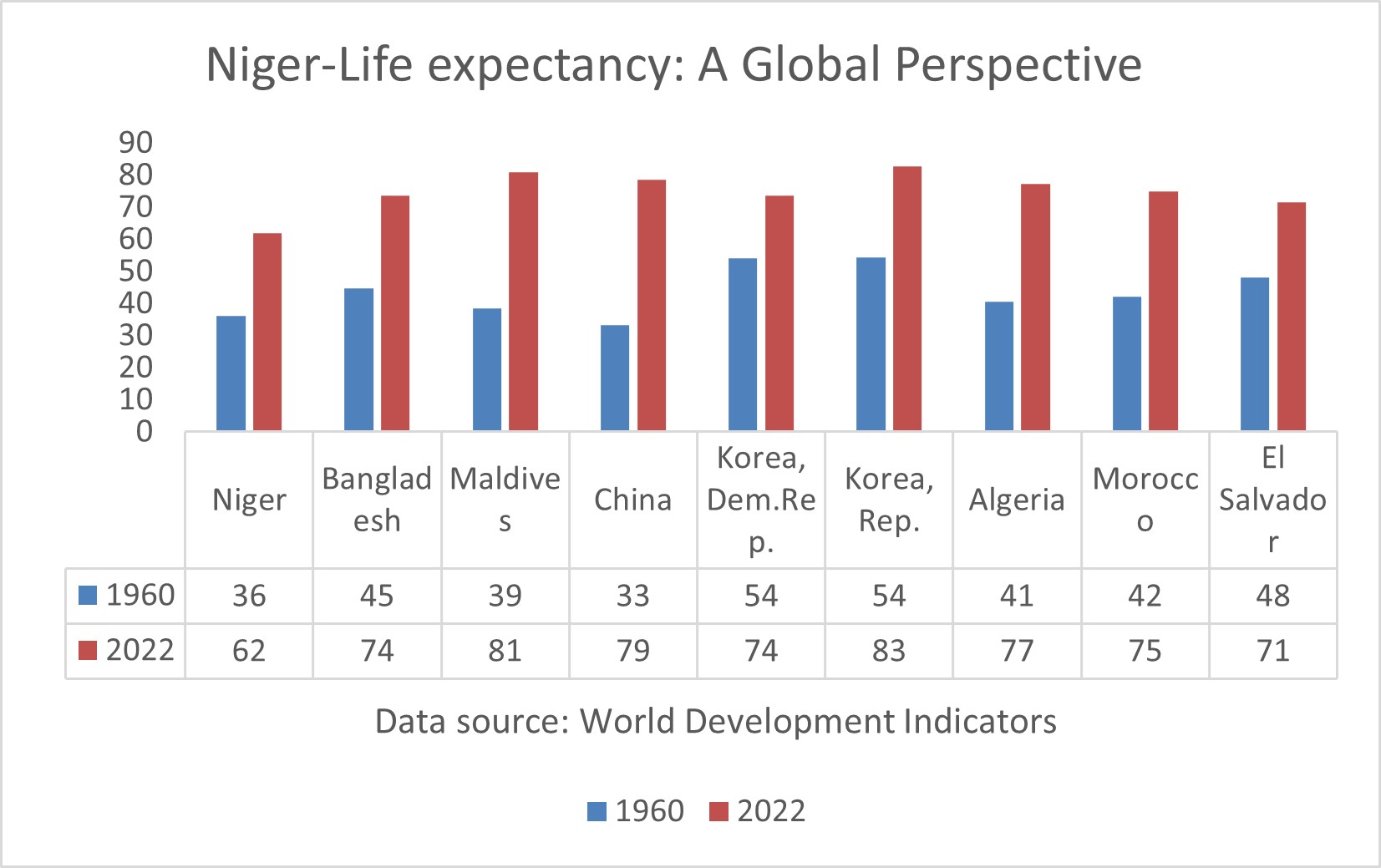
Niger-Mortality rate, under-5 (per 1000 live births): A Global Perspective
Since 1950, child mortality rates worldwide have significantly declined, mainly due to better living standards, healthcare access, nutrition, and safe drinking water. In affluent countries in Europe and America, rates have fallen below 4 percent, showcasing effective healthcare systems and socioeconomic stability. However, progress in many Sub-Saharan African nations remains slow; for example, Niger’s under-five mortality rate has only slightly decreased from 323 in 1980 to 117 in 2022. In contrast, Bangladesh and India have made remarkable strides, reducing their rates from 206 and 169 in 1980 to 29 in 2022, respectively. These figures highlight the persistent challenges of inadequate healthcare and the urgent need for structural reforms in governance across Sub-Saharan Africa to address child mortality and improve health outcomes for vulnerable populations.

Niger-Maternal mortality ratios (per 1000,000 live births): A Global Perspective
Niger’s maternal mortality ratio has improved from 867 in 2000 to 441 in 2020, but it is still alarmingly high, emphasizing the urgent need for care and action to enhance maternal health in the country. This progress contrasts sharply with the much lower ratios in Bangladesh, India, and Vietnam, which were 123, 103, and 46 in 2022. The ongoing fatalities related to pregnancy in Niger are compounded by a high birth rate and disturbing mortality figures. These issues highlight serious shortcomings in healthcare services and the ongoing lack of funding that affects healthcare systems across Sub-Saharan Africa. The significant difference in maternal health outcomes when compared to other developing regions underscores the critical need for increased investment in health infrastructure and resources, from local and international communities to ensure a healthier future for everyone.
